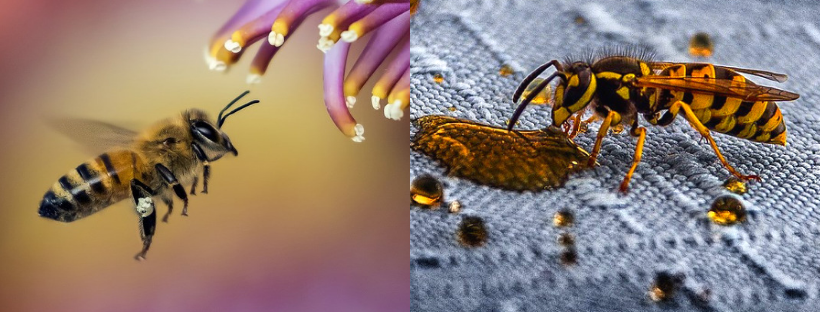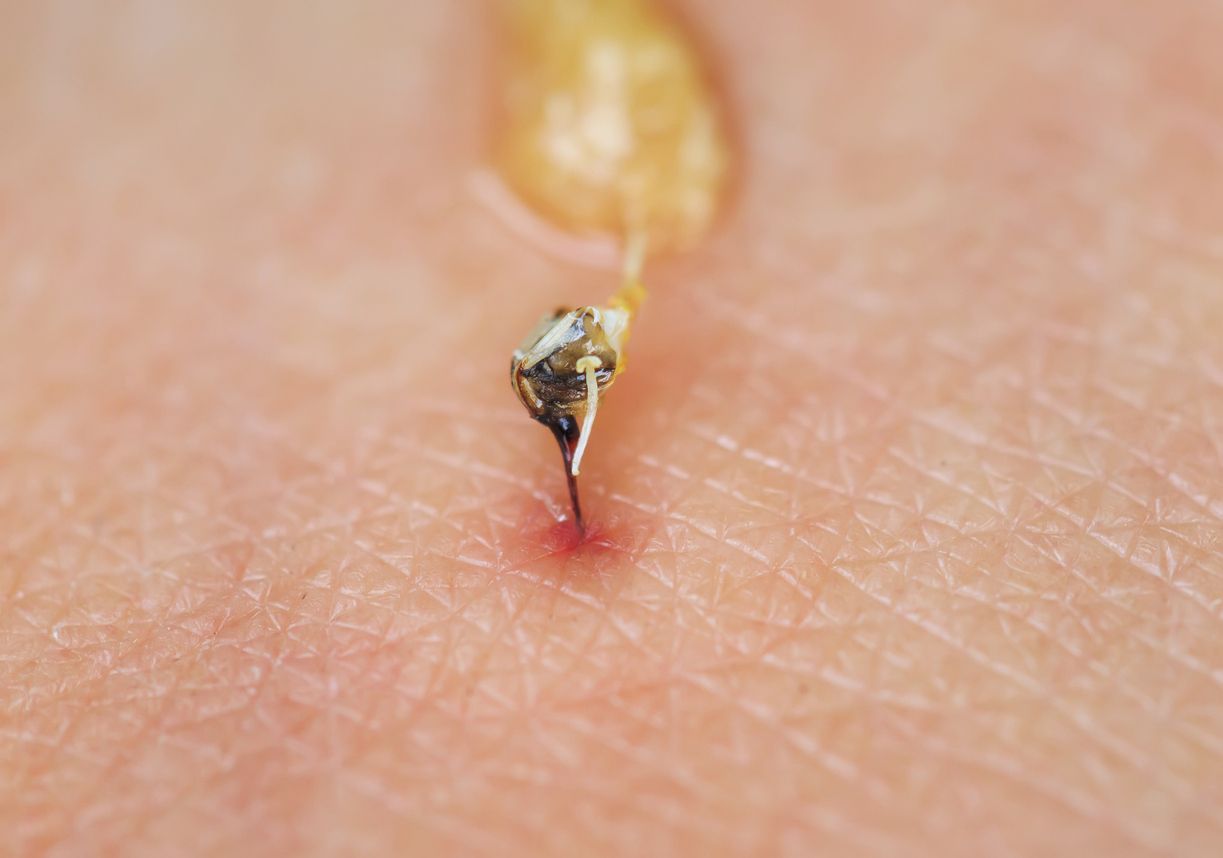Honey bees are usually well-tempered, however when you get too close to the entrance of a hive or when you accidently step on a bee, a sting might occur. The effect of a bee sting depends on how the stinger is removed and the wound is treated afterwards. Usually, a sting is painful but is otherwise relatively harmless. For people with an insect allergy however, a sting is very dangerous and can trigger a so-called anaphylactic shock. In this article we will show how to minimize the harm done.
Bees and Wasps
An insect sting is often believed to be a bee sting, however a bee is actually less likely to sting you compared to other insects such as wasps. Bees are generally not interested in snacking from our food or beverages, instead they are looking for suitable plants to collect nectar and pollen. Wasps on the other hand love to join your picknick and are considered to be more aggressive. Although the chemical composition of bee and wasp stings differ, their effects are similar. One can be allergic for either bees or wasps, or both.

Why does a honey bee sting?
Bees instinctively will do everything to defend their hive. If you come across an angry bee, it probably feels that you are a threat to the colony. Therefore, keep your distance from the entrance of a bee hive. In contrast to other insects like wasps or hornets, a honey bee will die when it stings. Logically, a honey bee will think twice before it actually attacks.
If you do get stung by a bee, the bee will release a particular sense or so-called pheromone. This «alarm pheromone» attracts other honey-bees to act defensive as well [1]. Because of this, beekeepers need to wash their clothes regularly, to avoid having too much of a smell and get the bees alarmed.
What happens when you are stung?
When a honeybee stings you, the stinger will be pushed into your skin. The stinger is barbed which means the stinger becomes lodged into your skin and rips from the bee’s body when she flies off [2]. The bee will not survive the rupture of the stinger and will therefore only be able to sting you once. However, the stinger will keep pumping venom into your body, so it is vital to remove the stinger as quickly as possible! The venom, which is called ‘Apitoxin’ causes pain and the skin will turn red and swell.

What to do when you get stung
Do’s
Remove the stinger as quickly as possible! You can use a pincet, credit card or your fingernails. Be careful not to remove the stinger with your fingers as you might squeeze the stinger and by doing so, squeeze all the venom into the wound. However, emphasise a quick removal over the method of removal [2].
To counter effect of the venom, apply ice to the sting site, the water will absorb some of the venom and the cooling will reduce the swelling.
Don’ts
Do not scratch, even though it can feel itchy, it will only intensify the itching and swelling.
Do not try to suck out the venom with your mouth, the venom will spread into your body much quicker through your mucous membranes [3].
Normally it will take a about a week and everything will be healed just fine. However, if the sting is in the neck, mouth or throat area, contact a doctor immediately! Severe swelling in these areas can block the airways and the victim’s ability to breathe [3].
What to do you when someone is allergic
In Switzerland around 3 to 4 % of the population suffers from insect allergy [4]. In this case a bee sting can be highly dangerous and even deadly if not treated quickly. The Apitoxin might cause a so-called «anaphylactic shock», which is an extreme reaction on an allergic substance. This is the «maximum» response of the immune system. As a result blood pressure drops significantly and airways narrow. This might make it difficult to breathe and cause skin reactions, nausea, vomiting, lose of consciousness and/or lead to a swollen tongue [3].
When you believe someone experience such as shock, contact medical assistance immediately. People with an insect allergic usually carry an anti-dose in the form of an EpiPen® or FastJekt® at them at all times. After using such anti-dose, one should still seek medical attention to ensure the anaphylactic shock does not return.
Disclaimer
All the information on this website – www.vatorex.ch – is published in good faith and for general information purpose only. The medical information provided on www.vatorex.ch is of a general nature and cannot substitute for the advice of a medical professional. Vatorex does not make any warranties about the completeness, reliability and accuracy of this information. Any action you take upon the information you find on this website (www.vatorex.ch), is strictly at your own risk.
Literature
[1] Bortolotti, L., & Costa, C. (2014). Chemical communication in the honey bee society. In Neurobiology of chemical communication. CRC Press/Taylor & Francis.
[2] Visscher, P. K., Vetter, R. S., & Camazine, S. (1996). Removing bee stings. The Lancet, 348(9023), 301-302.
[3] Brunner, L. (02.07.2019). Bienenstich: Was tun? Helsana. https://www.helsana.ch/de/blog/bienenstich
[4] SWICA. (10.08.2016) Was tun bei Wespen- und Bienenstichen. https://www.swica.ch/de-ch/ihre-gesundheit/gesundheitstipps/tipps/active/wespen-bienenstich